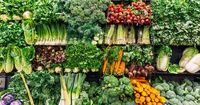For shoppers across Massachusetts and the nation, a trip to the produce aisle has become a sobering experience this summer. According to the U.S. Bureau of Labor Statistics, wholesale prices for domestic fresh and dry vegetables soared by 38.9% from June to July 2025 compared to the same period last year. This nearly 40% increase marks the steepest one-month jump for a summer month in almost a century, as reported by NBC senior business correspondent Christine Romans on TODAY on August 15, 2025.
The ripple effects are being felt everywhere from supermarket chains to local open-air markets like Boston’s historic Haymarket, where vendors are struggling to reconcile rising supply costs with customers’ expectations for affordable produce. "Sometimes it’s so high, it’s ridiculous. You can’t sell anything to make a profit," said Henry, a longtime Haymarket vendor, in an interview with WBZ-TV. His sentiment was echoed by fellow vendor TT Tilleo, who added, "We pay more and our customers over here still want the same deals."
So what’s driving this dramatic price spike? Experts point to a perfect storm of factors, both sudden and systemic. Tufts University professor William Masters, who teaches at the Friedman School of Nutrition and the Department of Economics, explained to WBZ-TV that while such fluctuations can seem shocking, they’re not entirely unprecedented for those in the produce trade. "Thirty-eight percent is a big jump, and if you’re a vegetable trader, you’ve seen that before," Masters said. He went on to clarify, "It has to do with weather, has to do with some supply disruption or a spike in demand."
Indeed, unpredictable weather events, including droughts, have wreaked havoc on crop yields in recent months. Farmers, already grappling with the uncertainties of climate, now face an added layer of stress from ongoing labor shortages. These shortages have been exacerbated by recent immigration enforcement actions, which have left many farm workers nervous to show up for work. NBC News reported that in June 2025, President Donald Trump’s administration resumed arrests of immigrant workers at agricultural businesses, restaurants, and hotels. In response to mounting concerns, Trump told Fox News his administration was considering temporarily halting immigration raids in select industries. However, the uncertainty has already taken a toll on the agricultural workforce, further straining supply chains.
Tariffs are also playing a significant role. As Christine Romans explained on TODAY, tariffs on imported vegetables and food can make domestic prices rise as well. Professor Masters reinforced this point, noting, "We see the consumer in the end, after a period of weeks, paying the bulk of the tariffs." The combined effect of tariffs, weather disruptions, and labor shortages has created a volatile market where prices are prone to sudden and dramatic changes.
For many consumers, the surge in vegetable prices is not just an abstract economic statistic—it’s hitting their wallets at a time when the overall cost of living remains a top concern. "This spike is something I think that just reminds people that the cost of living is still issue number one and there are still some significant pressures in terms of the prices we’re paying every day for everyday items. You can’t swap out vegetables. Vegetables are a pretty important part of the menu," Romans pointed out on TODAY.
The price hike at the wholesale level doesn’t stay there for long. Grocery stores, which typically operate on razor-thin margins, must decide whether to absorb the increased costs or pass them on to shoppers. While many chains have pledged to hold prices steady for as long as possible, there’s a limit to how much they can absorb. As Romans observed, "There’s always a point where companies need to pass on at least a portion of the increase to customers." In July, for example, ground beef prices reached $6.12 per pound—a nearly 12% increase from the previous year—while uncooked beef steaks averaged $11.49 per pound, up 8%. These increases suggest a broader trend of rising food costs, not limited to produce alone.
Back at Haymarket, vendors are feeling the squeeze from both sides. They’re paying more for their stock, but customers—many of whom rely on the market’s reputation for bargains—are reluctant to accept higher prices. "We’re still over here just trying to survive and help everybody out because you know, it’s a give and take," Tilleo told WBZ-TV. The market’s tradition of haggling and affordable produce is under threat, but vendors remain determined to keep it alive, even as their own profit margins dwindle.
For seasoned produce traders, the volatility of vegetable prices is a familiar, if unwelcome, part of the business. "If you look at the statistics, you can begin to have a sense of how the randomness is big and real, and the trends are big and real," Masters said. The current surge, he noted, is likely the result of both short-term disruptions and long-term structural issues—like tariffs and a shrinking immigrant workforce—that show no signs of abating.
Consumers, meanwhile, are left to wonder how high prices will climb and how long the increases will last. Romans cautioned that it’s too soon to say whether this is a one-off spike or the start of a sustained trend, but she acknowledged the anxiety it’s causing. "I like to watch a few months of these kinds of numbers to kind of see what direction things are going in. But this is certainly getting a lot of attention because we know that you can look at overall inflation statistics, but people like to look at things that they can touch and feel like eggs or vegetables or something in particular," she said.
As the summer draws to a close, the story of rising vegetable prices is still unfolding. For now, both vendors and shoppers are bracing for more uncertainty. The only certainty, it seems, is that the cost of putting fresh vegetables on the table has never felt so unpredictable—or so crucial to family budgets. The resilience of markets like Haymarket, and the adaptability of both sellers and buyers, will be tested in the months ahead as everyone waits to see what the next harvest—and the next set of economic data—will bring.




